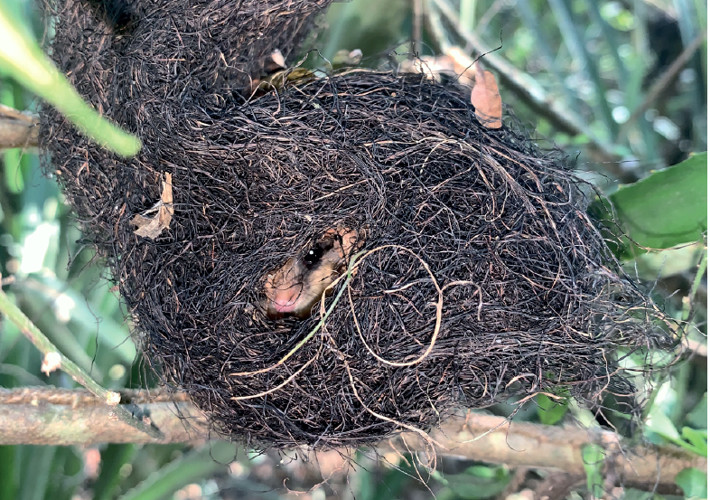Use of abandoned nests of golden-winged cacique Cacicus chrysopterus (Vigors, 1825) by Chacoan mouse opossum Cryptonanus chacoensis (Tate, 1931)
DOI:
https://doi.org/10.31687/SaremNMS23.4.4Palavras-chave:
Didelphidae, Icteridae, mammals of South America, nest use, ÑeembucúResumo
All Paraguayan specimens of the Chacoan mouse opossum have been taken on the ground despite simultaneous trapping efforts in trees. Two C. chacoensis individuals were discovered on two separate occasions resting on a large mass of leaves within fallen C. chrysopterus nests, 101.6 cm and 246 cm above the ground. A third fallen C. chrysopterus nest was discovered on a tree, 109.7 cm off the ground, containing a leaf mass approximately 1,550 m from the first nest and 132 m from the second. These findings suggest that the Chacoan mouse opossum may opportunistically use bird nests for roosting.
Referências
Belton, W. 1985. Birds of Rio Grande do Sul, Brazil. Part 2: Formicariidae through Corvidae. Bulletin of the American Museum of Natural History 180:1–242.
Bianchi, I. R., & S. L. Mendes. 2007. Ocelot (Leopardus pardalis) predation on primates in Caratinga Biological Station, southeast Brazil. American Journal of Primatology 69:1173–1178. https://doi.org/10.1002/ajp.20415.
Castillo, H., R. P. Clay, & J. de Egea. 2005. Atlas de las aves de Paraguay. Asociación Guyra Paraguay, Asunción, Paraguay.
Chatellenaz, M., & L. Ferraro. 2000. Materiales vegetales y fúngicos en nidos de aves del noreste Argentino y Paraguay. Facena 16:103–119.
Ferreira, G., E. Nakano-Oliveira, G. Genaro, & A. Chaves. 2013. Diet of the coati Nasua nasua (Carnivora: Procyonidae) in an area of woodland inserted in an urban environment in Brazil. Revista Chilena de Historia Natural 86:95–102. https://doi.org/10.4067/S0716-078X2013000100008.
Giacomo, A. G., S. F. Krapovickas, & J. Pereira. 2005. Historia natural y paisaje de la Reserva el Bagual, provincia de Formosa, Argentina: inventario de la fauna de vertebrados y de la flora vascular de un área protegida del Chaco Húmedo. 4th edition. Aves Argentinas/Asociación Ornitológica del Plata, Buenos Aires.
Granzinolli, M. A. M., & J. Motta-Junior. 2006. Small mammal selection by the white-tailed hawk in southeastern Brazil. Wilson Journal of Ornithology 118:91–98. https://doi.org/10.1676/1559-4491(2006)118[0091:SMSBTW]2.0.CO;2.
Massoia, E. J., & A. Fornes. 1972. Presencia y rasgos etoecológicos de Marmosa agilis chacoensis Tate en las Provincias de Buenos Aires, Entre Ríos y Misiones (Mammalia: Marsupialia: Didelphidae). Revista de Investigación Agropecuaria INTA 9:71–82.
Motta-Junior, J., C. Alho, & S. Belentani. 2004. Food habits of the striped owl in south east Brazil. Raptors worldwide (R. D. Chancellor & B. U. Meyburg, eds.). World Working Group on Birds of Prey and Owls, Budapest.
Owen, R., H. Sánchez, L. Rodriguez, & C. Jonsson. 2018. Composition and characteristics of a diverse didelphid community (Mammalia: Didelphimorphia) in sub-tropical South America. Occasional Papers, Museum of Texas Tech University 359:1–18.
Smith, P. 2009. Cryptonanus chacoensis. FAUNA Paraguay Handbook of the Mammals of Paraguay 34:1–7.
Smith, P., H. Pheasey, K. Atkinson, J. Ramakers, & J. Sarvary. 2012. The Didelphimorphia (Didelphidae) of Reserva Natural Laguna Blanca, Departamento San Pedro, Paraguay. Acta Zoológica Lilloana 56:141–153.
Teta, P., & J. Contreras. 2003. Primeros antecedentes de la dieta de la lechuza de campanario (Tyto alba) en el departamento Ñeembucú (Paraguay). Hornero 18:57–59.
Teta, P., & G. M. Martin. 2016. Cryptonanus chacoensis. The IUCN Red List of Threatened Species 2016:e.T136845A22177997. https://doi.org/10.2305/IUCN.UK.2016-1.RLTS.T136845A22177997.en.
Umetsu, F., & R. Pardini. 2007. Small mammals in a mosaic of forest remnants and anthropogenic habitats—evaluating matrix quality in an Atlantic forest landscape. Landscape Ecology 22:517–530. https://doi.org/10.1007/s10980-006-9041-y.
Voss, R. S., D. P. Lunde, & S. A. Jansa. 2005. On the contents of Gracilinanus Gardner and Creighton, 1989, with the description of a previously unrecognized clade of small didelphid marsupials. American Museum Novitates 3482:1–34.
Voss, R. S., P. Myers, F. Catzeflis, A. P. Carmignotto, & J. Barreiro. 2009. The six opossums of Félix de Azara: identification, taxonomic history, neotype designations, and nomenclatural recommendations. Bulletin of the American Museum of Natural History 331:406-433.

Downloads
Publicado
Como Citar
Edição
Seção
Licença
Copyright (c) 2023 Kimberley Jordan, George Hicks , Frances O'Leary

Este trabalho está licenciado sob uma licença Creative Commons Attribution-NonCommercial 4.0 International License.

